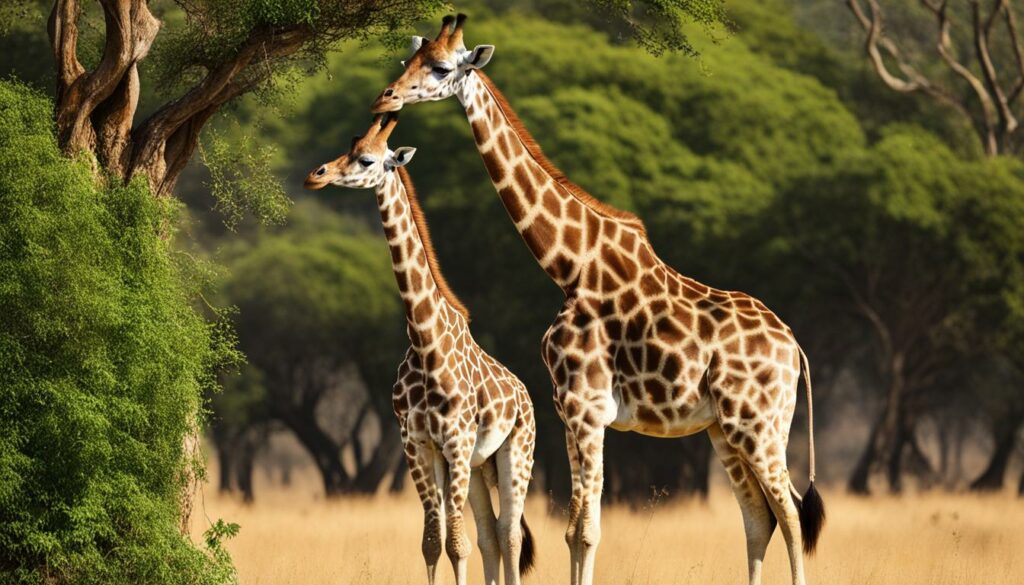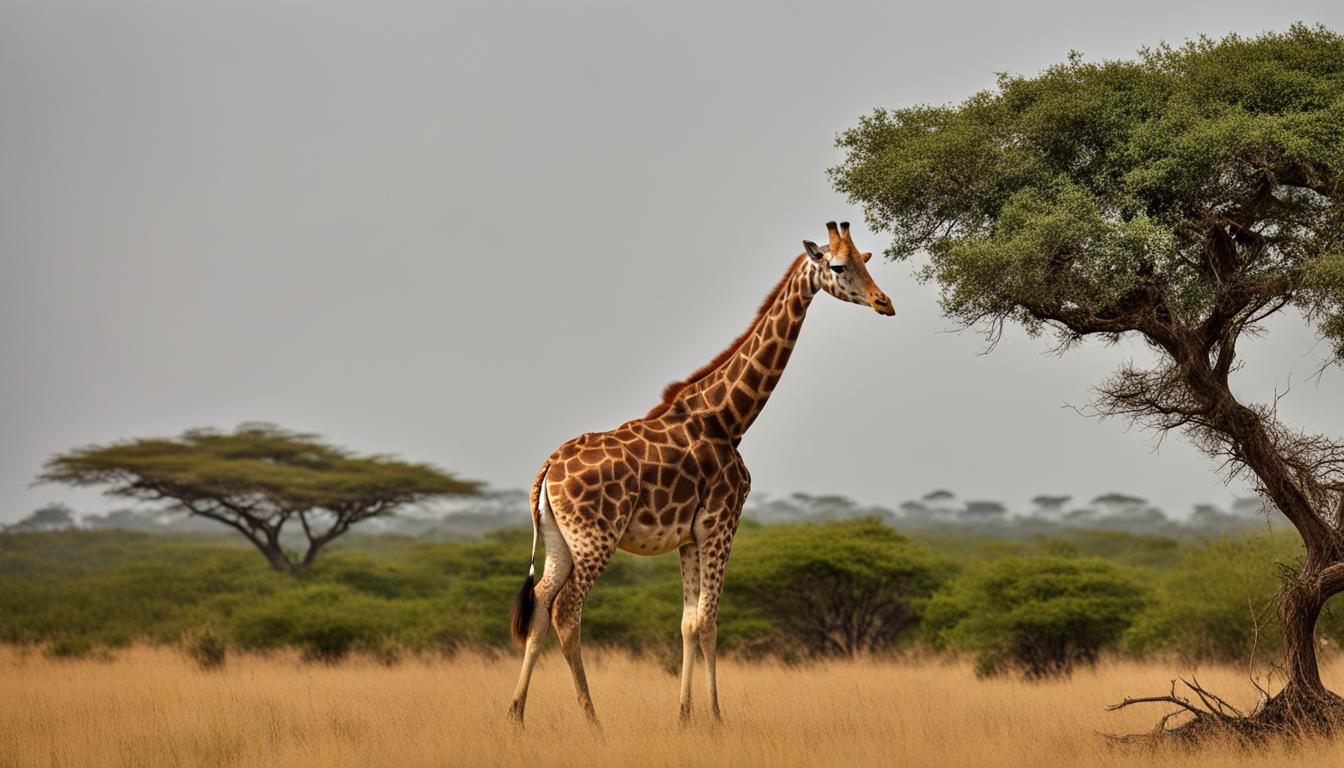Have you ever wondered about the diet of giraffes? These majestic creatures have unique food preferences and feeding habits that make them fascinating to study. In this section, we will explore the natural diet of giraffes, their browsing behavior, and their nutritional requirements. So, let’s dive in and discover what makes these herbivores so special!
Giraffe Diet Variations Across Different Species
Giraffes, majestic creatures of the African savanna, exhibit diverse dietary preferences and feeding habits across different species. Let’s explore the unique diet of each giraffe species and the habitats they inhabit.
Southern Giraffe (Giraffa giraffa)
The Southern Giraffe primarily feeds on leaves, shoots of trees, flowers, acacia bark, pods, and seeds. It has adapted to its southern African habitat by consuming a variety of plant species, ensuring it meets its nutritional requirements while surviving in a challenging environment.
Masai Giraffe (Giraffa tippelskirchi)
The Masai Giraffe has a preference for acacia leaves, twigs, and a variety of seasonal fruits. Its diet reflects the abundance of acacia trees in its range and highlights its specialized feeding habits.
Reticulated Giraffe (Giraffa reticulata)
The Reticulated Giraffe’s diet consists of seed pods, leaves, and fruits from preferred trees such as acacia, wild apricot, and mimosa. This species has adapted to its arid habitat by consuming the available plant resources to sustain its nutritional needs.
Northern Giraffe (Giraffa camelopardalis)
The Northern Giraffe’s diet includes a range of plant materials, including shoots, grains, nuts, leaves, flowers, and fruits. This species is known for its ability to adapt its diet to the diverse ecosystems it inhabits across northern Africa.
Each giraffe species has evolved to thrive in specific habitats, utilizing different food sources to satisfy their unique dietary requirements. Understanding these variations enhances our appreciation for the ecological diversity and adaptability of these remarkable herbivores.
| Giraffe Species | Preferred Diet | Habitat |
|---|---|---|
| Southern Giraffe | Leaves, shoots, flowers, acacia bark, pods, and seeds | Southern Africa |
| Masai Giraffe | Acacia leaves, twigs, and seasonal fruits | East Africa |
| Reticulated Giraffe | Seed pods, leaves, and fruits from preferred trees | Kenya, Ethiopia |
| Northern Giraffe | Shoots, grains, nuts, leaves, flowers, and fruits | North Africa |
These distinct giraffe species and their dietary preferences contribute to the overall biodiversity of African ecosystems, highlighting the intricate relationship between herbivores and their environments.
“The unique diets of giraffe species reflect their remarkable ability to adapt to different habitats and food availability, showcasing the evolutionary diversity of these magnificent creatures.”
– Giraffe Researcher
Giraffe Feeding Adaptations and Peculiarities
Giraffes have evolved unique feeding behaviors and adaptations that allow them to thrive in their environment. One of the most remarkable adaptations is their ability to eat acacia leaves despite the presence of thorns. Their long, maneuverable tongues and tough lips enable them to strip the leaves from the branches without getting injured. This adaptation allows giraffes to access a valuable food source that is abundant in their habitats.
Another intriguing behavior of giraffes is their practice of osteophagy, which involves chewing on bones. This behavior is believed to be a way for giraffes to obtain essential nutrients such as phosphates and calcium. By consuming bones, giraffes supplement their diet and ensure they meet their nutritional requirements. This behavior sets giraffes apart from other herbivores and highlights their ability to adapt to their surroundings.
Giraffes also display a fascinating feeding behavior in the presence of poisonous euphorbia trees. During the winter months, when parasites are more prevalent, giraffes consume small quantities of these toxic trees. The chemicals in the euphorbia trees have anti-parasitic properties, helping giraffes eliminate internal and external parasites. This unique feeding habit demonstrates the intelligence and adaptation skills of giraffes in obtaining necessary nutrients and maintaining their health.
“Giraffes have evolved remarkable feeding adaptations that allow them to browse on leaves despite the presence of thorns, chew on bones for essential nutrients, and consume small amounts of toxic trees to combat parasites.”
Giraffes and Acacia Trees: A Delicate Relationship
One of the most interesting aspects of giraffe feeding adaptations is their relationship with acacia trees. Acacia trees are a major food source for giraffes, but they are equipped with formidable thorns as a defense mechanism. Despite this challenge, giraffes have developed a remarkable way of feeding on acacia leaves. Their tongues and lips are tough and agile, allowing them to strip the leaves from the branches without harm. This unique feeding adaptation enables giraffes to access a nutrient-rich food source and highlights their specialized feeding behavior in the wild.
Giraffes’ ability to consume acacia leaves has a significant impact on the ecosystem. By selectively browsing on these trees, giraffes stimulate new shoot growth, which benefits the acacia population and promotes a healthy tree community. In addition, giraffes’ seed consumption and subsequent dispersal play a crucial role in seed germination and the overall biodiversity of the savannah. Giraffes can be considered important pollinators, as they transfer pollen from one flower to another while feeding on their preferred plants.
| Giraffe Feeding Adaptations | Impact on Ecosystem |
|---|---|
| Eating acacia leaves despite thorns | Stimulates shoot growth and maintains a healthy tree community |
| Consuming bones for essential nutrients | Supplements giraffes’ diet and ensures nutritional requirements are met |
| Feeding on poisonous euphorbia trees | Eliminates internal and external parasites and contributes to overall health |
| Selective browsing and seed dispersal | Promotes seed germination and enhances biodiversity |
Giraffes’ unique feeding adaptations and behaviors not only enable their survival but also have a profound impact on the ecosystems they inhabit. Through their feeding habits, giraffes contribute to the balance and diversity of plant species, while also ensuring their own nutritional needs are met in the challenging wild.

Giraffe Feeding Patterns and Habits
Giraffes have fascinating feeding patterns and habits that contribute to their survival and ecological impact. Understanding these behaviors provides valuable insights into the life of these magnificent creatures.
Feeding Time and Frequency: Giraffes spend a significant amount of their day feeding, especially during certain times of the year. They may dedicate up to 75% of their time to browsing, particularly when high-quality forage is available. Feeding patterns often change based on the availability of food, with increased feeding during the dry season when quality forage becomes scarce.
Moonlit Night Feeding and Rumination: Giraffes are not limited to daytime feeding. They are active at night as well, with a preference for feeding during moonlit nights. This behavior allows them to take advantage of the available light to locate and consume food. During dark nights, giraffes engage in rumination, which involves regurgitating partially digested food and re-chewing it to aid digestion.
Impact on Plant Species and Seed Consumption: Giraffes play a vital role in their ecosystem by impacting plant species through their feeding habits. As they browse on trees and shrubs, they stimulate shoot production and shape the growth and distribution of certain plant species. Additionally, giraffes also contribute to seed consumption and dispersal, aiding in the regeneration of plant populations.
Giraffes as Pollinators: While not traditionally recognized as pollinators, giraffes unknowingly facilitate pollination as they move from one flowering plant to another in search of food. Pollen may adhere to their fur or be carried on their long tongues, allowing for cross-pollination between plants.
Giraffe Feeding Habits in Action
Observing giraffes in their natural habitat provides a glimpse into their unique feeding habits. From gracefully stretching their necks and maneuvering their long tongues to reach their preferred forage, to carefully selecting plants based on their nutritional needs, giraffes exhibit remarkable adaptability and intelligence when it comes to feeding.
“Giraffes have evolved to thrive on a diet that best suits their specific needs and the environment they inhabit. Their feeding habits showcase their ability to find and consume the necessary nutrients for survival.”
By understanding the feeding patterns and habits of giraffes, researchers and conservationists can develop strategies to support their dietary needs and ensure their continued well-being. Furthermore, recognizing the vital role giraffes play in shaping their ecosystem through their feeding behaviors highlights the importance of protecting these majestic animals and the habitats they depend on.
| Feeding Habit | Significance |
|---|---|
| Feeding Time and Frequency | Giraffes dedicate up to 75% of their time to browsing, adjusting their feeding based on food availability and season. |
| Moonlit Night Feeding and Rumination | Giraffes take advantage of moonlit nights to feed and engage in rumination during dark nights for efficient digestion. |
| Impact on Plant Species and Seed Consumption | Giraffes shape plant communities by stimulating shoot production and aiding in seed dispersal through their feeding habits. |
| Giraffes as Pollinators | While not recognized as traditional pollinators, giraffes inadvertently aid in cross-pollination as they move between flowering plants. |
Conclusion
The giraffe’s diet consists primarily of browsing on various leaves, buds, shoots, flowers, and fruits. They have adapted to their specific regions and adjust their intake based on seasonal and plant stage variations. As herbivores, giraffes play a vital role in maintaining the balance of their habitats by impacting plant species and contributing to seed dispersal and potential pollination.
With their unique feeding behaviors, such as consuming acacia leaves despite the thorns and engaging in osteophagy, giraffes showcase their adaptability and intelligence in obtaining essential nutrients. They also exhibit specialized feeding habits, spending a significant portion of their day browsing for food, especially during the dry season. Giraffes are active at night, with a preference for feeding during moonlit nights and engaging in rumination during dark nights.
Understanding the giraffe’s diet provides valuable insights into the complexity of these magnificent creatures and their crucial role in the ecosystem. Their ability to thrive in different environments and adapt to varying nutritional needs demonstrates their remarkable resilience. By delving into the intricacies of giraffe feeding behavior, we gain a deeper appreciation for these graceful animals and the important role they play in maintaining the delicate balance of nature.
Does a Giraffe’s Diet Affect Its Reproduction Cycle?
The giraffe’s diet is fundamental in influencing its reproduction cycle. These majestic creatures typically rely on their natural food sources, such as leaves and twigs from trees, to meet their nutritional needs. However, a poor diet lacking essential nutrients can disrupt the giraffe reproduction cycle, leading to reproduction challenges and decreased fertility. Therefore, maintaining a balanced diet is crucial for ensuring successful reproduction among giraffes.
FAQ
What do giraffes typically eat, and how do they feed?
Giraffes are predominantly browsers and mainly eat leaves and buds on trees and shrubs. They also consume herbs, climbers, and vines, and have a preference for flowers and fruits when in season. Grass makes up a very small proportion of their diet. Giraffes adapt their diet to the food species available in their specific region, as well as the season and growth stage of plants. Males are able to feed at higher levels than females, but both can stretch their heads and necks vertically to reach their preferred forage. The diet of adult females is nutritionally richer than that of males, who consume higher proportions of fiber and lignin. Giraffes spend a significant amount of time browsing and feeding, especially during the dry season when quality forage is more scarce.
Giraffe diet variations across different species
Giraffes are classified into different species based on their geographic ranges and morphology. The Southern Giraffe (Giraffa giraffa) mainly feeds on leaves, shoots of trees, flowers, acacia bark, pods, and seeds. The Masai Giraffe (Giraffa tippelskirchi) primarily eats acacia leaves, twigs, and a variety of seasonal fruits. The Reticulated Giraffe (Giraffa reticulata) consumes seed pods, leaves, and fruits of preferred trees like acacia, wild apricot, and mimosa. The Northern Giraffe (Giraffa camelopardalis) feeds on shoots, grains, nuts, leaves, flowers, and fruits. Each species has its own preferred diet and can be found in different habitats across Africa.
Unique feeding behaviors of giraffes
Giraffes have unique feeding behaviors that set them apart from other herbivores. They are able to eat acacia leaves despite the thorns by using their long, maneuverable tongues and tough lips. Giraffes engage in osteophagy, which is the chewing of bones, to obtain phosphates and calcium from their diet. They also consume poisonous euphorbia trees in small quantities during the winter to eliminate internal and external parasites. These feeding behaviors showcase the adaptability and intelligence of giraffes in obtaining essential nutrients from their environment.
Giraffe feeding patterns and habits
Giraffes spend the majority of their day feeding, especially during certain times of the year when they may dedicate up to 75% of their time to browsing. Feeding patterns often change depending on the availability of high-quality forage, with increased feeding during the dry season. Giraffes are also active at night, with a preference for feeding during moonlit nights and rumination during dark nights. They play a significant role in the ecosystem as they can impact plant species by stimulating shoot production and promoting seed dispersal. Giraffes may also contribute to pollination processes.










